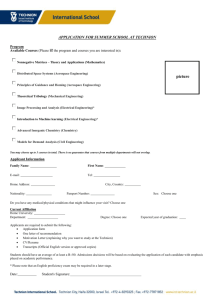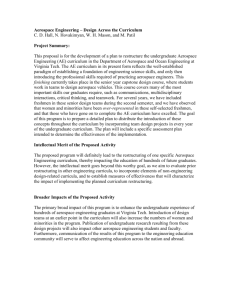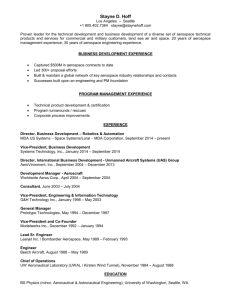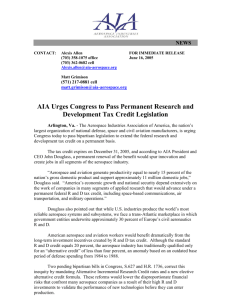What does an Aerospace Engineer do?
advertisement
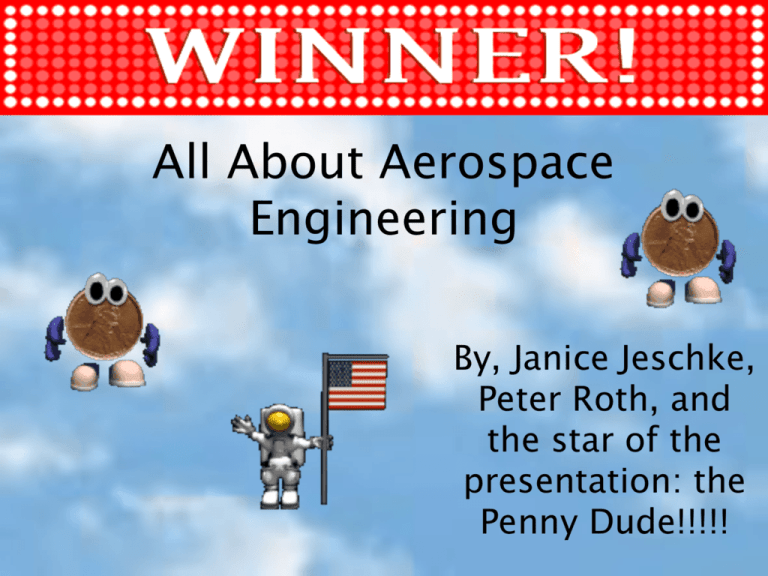
All About Aerospace Engineering By, Janice Jeschke, Peter Roth, and the star of the presentation: the Penny Dude!!!!! What does an Aerospace Engineer do? • Design and build aircrafts, such as commercial or military airplanes • Spacecraft • Design different kinds of machines, build them, and test to make sure they can do what they are supposed to. • Designs have to be very exact, and they have to solve all kinds of problems before the airplane is built. • For example, they have to figure out not only what equipment an aircraft needs, but also what materials it will use, how much the equipment weighs and exactly how much space it will take up in the aircraft. Education and Training • If you are interested in a career in aerospace engineering, you should study as much math and science as possible. • Physics, the science of motion, is particularly important for aerospace engineers to know. • Courses in English, speech, and communications, are also important when you have to talk, or just explain detailed and complicated plans. • Jobs in aerospace engineering require a bachelor’s degree • Many college take 4 years to complete, while others take 5-6 years. • Aerospace engineers must be licensed. 1. 2. 3. 4. 5. Designs products and systems, including testing methods, production costs, quality standards, and completion dates. Reviews the products to determine if there are any damages or problems. Writes documents, reports, or handbook for customers and staff. Maintains records of performance for future reference. Improves production methods and tries to reduce the cost. • Mathematics- need to be able to solve problems • Science- use scientific rules and methods to solve problems • Active Learning- need to be able to learn quick and use new information for current and future problems and decision making. • Reading Comprehension- understand directions, written sentences and paragraphs. • Technology Design- be able to use today's technology to make your job easier. • Quality Control Analysis- be able to conduct tests, to prove your thinking, or test safety. • Critical Thinking- use logic to identify the strengths and weaknesses of your projects. • The average salary in 2002, was $72,750. The 50% from the middle class earned between $59,520 and $88,310. • The lowest 10% earned less then $49,640 • The highest 10% earned more than $105,060 • These are some of the average in 2002 were: Federal Government$81,830 Architectural, engineering and related services $74,890 Aerospace product and parts manufacturing $70,920 Neil Armstrong • Born on August 5, 1930 • Education- he attended Purdue University, and received a Bachelor of Science degree in Aeronautical Engineering in 1955 • Position- commander • Achievements- first docking of two orbiting spacecraft, in 1966. He served as commander of the backup crew for the Apollo 8 lunar orbital mission in 1968. He also escaped death during training in a crash of the lunar landing training vehicle. Kalpana Chawla • Born in India • Education- Kalpana graduated from Tagore School, Karnal, India in 1976. She has a bachelor of science degree in aeronautical engineering, a master of science degree in aerospace engineering, and a doctorate of philosophy in aerospace engineering. • She worked at NASA, and was a great astronaut. • Kalpana went on many missions. She went on the STS-87 (the fourth US Micro gravity Payload flight), and she was on the Columbia Disaster. Rutgers The Aerospace program at Rutgers emphasis the understanding of fundamentals and engineering methods of analysis and reasoning. Projects Some of the projects that they are working on a Rutgers have to do with energy transfer rates, internal combustion, robots, solar systems, rocket engines, gas turbines and nuclear reactors. Professor There are many aerospace engineers at Rutgers, but we were especially interested in Ellis Harold Dill. He is a university professor in the department of Mechanical and Aerospace engineering. Some of his professional interests include the Mechanics of Solids, Continuum Mechanics, Finite Element Methods, and Aerospace Structures. Mr. Dill has also had many publications like attending The Shear Center and Kirchhoff’s Theory of Rods. We also found out that he loves to play the game bridge. Jobs for Aerospace engineers • You can be part of the NASA program • You could also work at CorpTech. Have a save flight!
